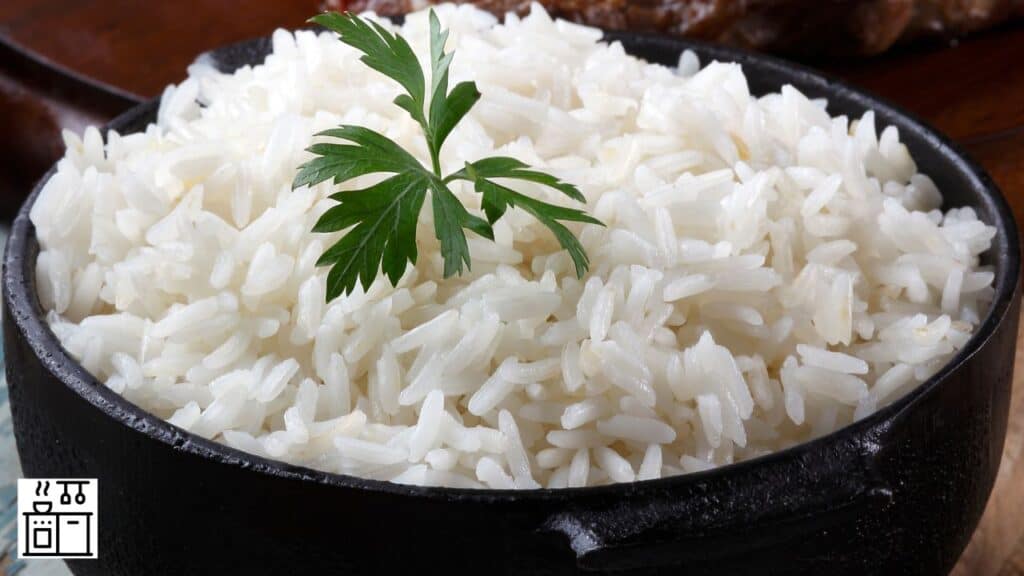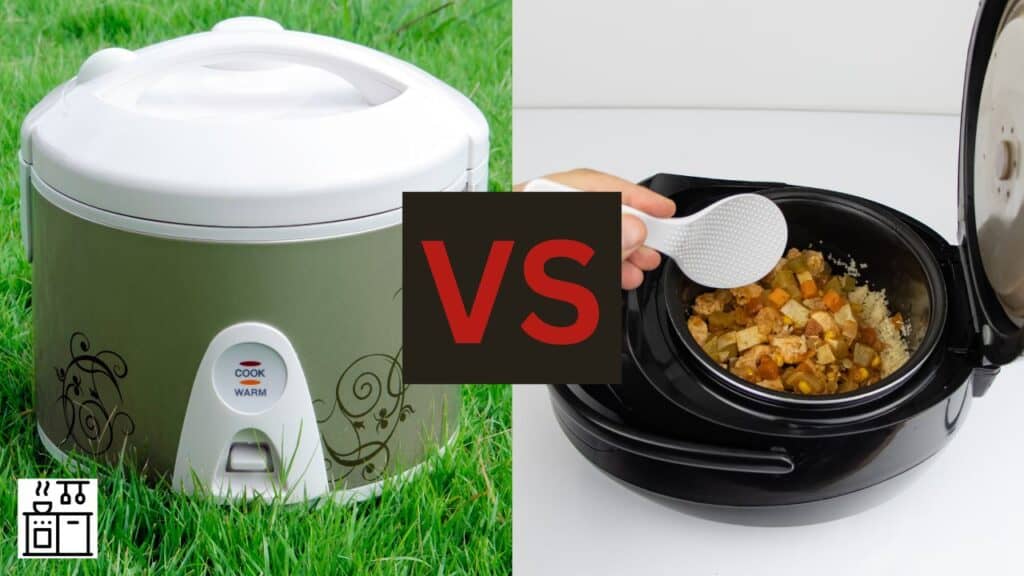Rice cookers and Instant Pots are two kitchen appliances commonly seen in household kitchens.
You can use either of them to make various dishes. But there are significant differences in how they operate and the results they generate.
Let’s take a closer look at how they differ from each other.
- Key Differences Between a Rice Cooker and Instant Pot
- 1. Difference in Function
- 2. Difference in Design
- 3. A Rice Cooker Works Like a Steamer but An Instant Pot Works Like a Pressure Cooker
- 4. Both Devices Can Cook Rice
- 5. Instant Pots Usually Need Less Water and Cook Faster
- 6. You Can Cook More Recipes in An Instant Pot
- 7. Instant Pots Are Generally More Expensive
- To Summarize…
Key Differences Between a Rice Cooker and Instant Pot
You can prepare certain recipes in both rice cookers and Instant Pots.
So how exactly are these devices different from each other?
Read on to find out.
1. Difference in Function
A rice cooker is a simple device that cooks rice automatically. You can also use it to cook other grains and a few other recipes.
It has a basic design consisting of a cooking pot inside a casing with a heating element.
The in-built thermostat regulates the temperature and decides when to shut off or switch the appliance to the “Keep warm” mode.
An Instant Pot is a multi-functional appliance. It can cook various types of dishes, including rice.
This appliance uses pressure to cook food using high steam.
2. Difference in Design
A rice cooker is a simple appliance with a few parts. These include:
- A cooking pot,
- Heating element,
- Thermal sensor,
- Basic control panel with just a few options to choose the cooking time and the mode,
- Lid,
- Steam vent to release excess steam generated during cooking,
- Inner cooking pot to hold the rice and water, and
- Power cord.
Some rice cookers come with a steam rack to hold vegetables or meat, and it fits inside the cooking pot.
Rice cookers will automatically shut down or switch to the “Keep warm” mode after the rice is cooked.
An Instant Pot is more complicated than a rice cooker because it can cook various ingredients.
Hence, it has more parts including the following:
- Stainless steel lid with a silicone rubber sealing ring to seal the top,
- Stainless steel or ceramic inner pot to hold the ingredients for cooking,
- Internal heating element at the base,
- Digital control panel to set the cooking function, time, temperature, and pressure level,
- An internal microprocessor that creates a precise cooking environment,
- Pressure valve to release and adjust the pressure inside the cooking vessel.
- Steam release valve to expel excess steam generated during the cooking process,
- Condensation collector to collect excess liquid generated during cooking, and
- Power cord.
Apart from these standard parts, some Instant Pot models may also have additional parts like a steamer or sous vide rack.
3. A Rice Cooker Works Like a Steamer but An Instant Pot Works Like a Pressure Cooker
A rice cooker is basically an automated steamer. It doesn’t use pressure to cook food.
It’s based on the principle of boiling water and cooking food using steam.
When you switch on a rice cooker, the heating element heats the pot and makes the water boil.
The rice absorbs water as it cooks and the grains expand. The lid of the rice cooker traps the steam, allowing the rice to cook evenly.
When the water reaches the boiling point, the temperature sensor detects the temperature change.
Consequently, it switches from “cook” mode to “keep warm.” This keeps the device at a steady temperature till the rice is served.
An Instant Pot is based on the concept of pressure cooking.
The food to be cooked is placed in a sealed container which traps steam and creates high pressure.
The high temperature and pressure inside the container help the food cook quickly.
The difference between an Instant Pot and a regular pressure cooker is the amount of control the latter allows.
You can use the digital display panel to adjust the cooking time and pressure level as per need.
It also comes with a variety of cooking modes allowing you more flexibility.
The Instant Pot also switches to keep warm mode till it’s time to serve the food.
4. Both Devices Can Cook Rice

Both the Instant Pot and the rice cooker can cook rice. However, the cooking method differs.
The cooking time and amount of liquid required for cooking vary for different varieties of rice.
So rice cookers usually have different options to choose from.
There are dedicated buttons for white, brown, long-grain, or short-grain rice. So, customization is easy.
However, Instant Pots have a single dedicated button for cooking rice. This setting is specifically designed for long-grain rice.
For other varieties of rice, most brands recommend using the standard pressure cook program.
It may involve some trial and error to figure out how to use the device for different types of rice.
5. Instant Pots Usually Need Less Water and Cook Faster
The Instant Pot cooks rice by heating the water and rice to a high temperature and generating high pressure.
This technique of pressure cooking lets the food cook very fast. So, you can cook rice very quickly in an Instant Pot.
The rice cooker follows a different principle of steaming. This usually takes more time because the water heats gradually.
So you may have to wait longer for the rice to cook.
Similarly, you will need more water for cooking rice in a rice cooker because the cooking isn’t under high pressure.
Generally, the water-to-rice ratio is 1:2 for a rice cooker, but it can vary according to the type of rice.
In an Instant Pot, high pressure makes the rice cook faster. It also reduces the need for too much liquid.
So you can follow a 1:1 ratio of rice and water in an Instant Pot.
6. You Can Cook More Recipes in An Instant Pot
Instant Pots can cook a variety of recipes besides rice. The appliance acts like a slow cooker, pressure cooker, food warmer, and steamer.
You can also sauté ingredients in an Instant Pot. Some models have a yogurt-making function.
Advanced models even come with air frying and sous-vide functionalities.
A rice cooker is much simpler. It’s mainly built for cooking rice and similar grains.
Apart from rice, you can use it to cook quinoa, oats, pasta, and other grains.
But it’s not suitable for stir-frying or any other mode of cooking.
Some rice cookers come with a steaming basket that you can use to steam vegetables, meat, or dumplings while cooking rice.
7. Instant Pots Are Generally More Expensive
You can find rice cookers and Instant Pots at different price ranges in the market. The price will often depend on the functions these appliances provide.
However, Instant Pots are generally more expensive than rice cookers of similar capacity.
The additional electronic circuitry and complex functionalities of an Instant Pot increase the cost of these appliances.
These devices include a microprocessor inside that allows you to customize the cooking programs. This is complex electronics which adds to the cost.
A rice cooker has a simpler internal circuit. It has a limited range of functions and fewer options.
So you can customize the operation to a limited extent. You can’t do much more than steam rice and other ingredients in a rice cooker.
Some models may set off an alarm or switch to the keep warm mode after cooking.
Due to the simple nature of the operation, it’s usually cheaper than an Instant Pot.
Further Reading: 8 Simple Steps to Use a Rice Cooker
To Summarize…
| Features | Rice Cooker | Instant Pot |
|---|---|---|
| Function | Mainly cooks rice and a few other grains. | Multi-functional. Cooks a variety of dishes. |
| Design | Simple with limited buttons and options. | Complex design with more components. |
| Principle | Uses steam for cooking. | High-pressure cooking. |
| Cooking rice | Different settings for different types of rice. | Has a single setting for cooking rice. |
| Water requirement | Requires more water. | Needs less water. |
| Cooking options | Recipes based on boiling and steaming only. | Extensive range of options including sauteing, sous-vide, steaming, boiling, and making yogurt. |
| Price | Typically cheaper than pressure cookers. | More expensive than rice cookers. Price increases as the model becomes more complex. |

